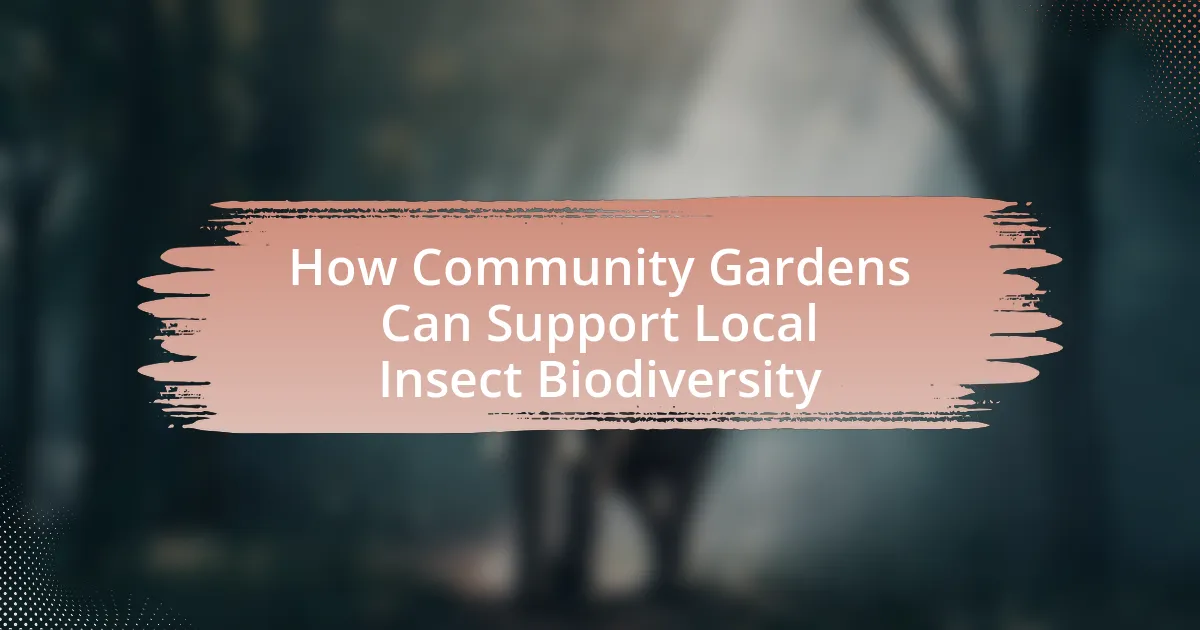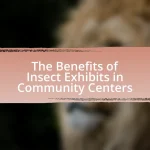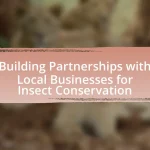Community gardens play a vital role in supporting local insect biodiversity by providing diverse habitats and food sources for various insect species, including essential pollinators like bees and butterflies. These gardens enhance biodiversity through a variety of plants, which attract a greater number of insect species and contribute to healthier ecosystems. Key practices that promote insect biodiversity include planting native species, minimizing pesticide use, and creating habitats such as insect hotels. Additionally, community engagement and educational programs are crucial for raising awareness and advocating for insect-friendly policies, ultimately fostering a balanced environment that benefits both insects and the surrounding community.
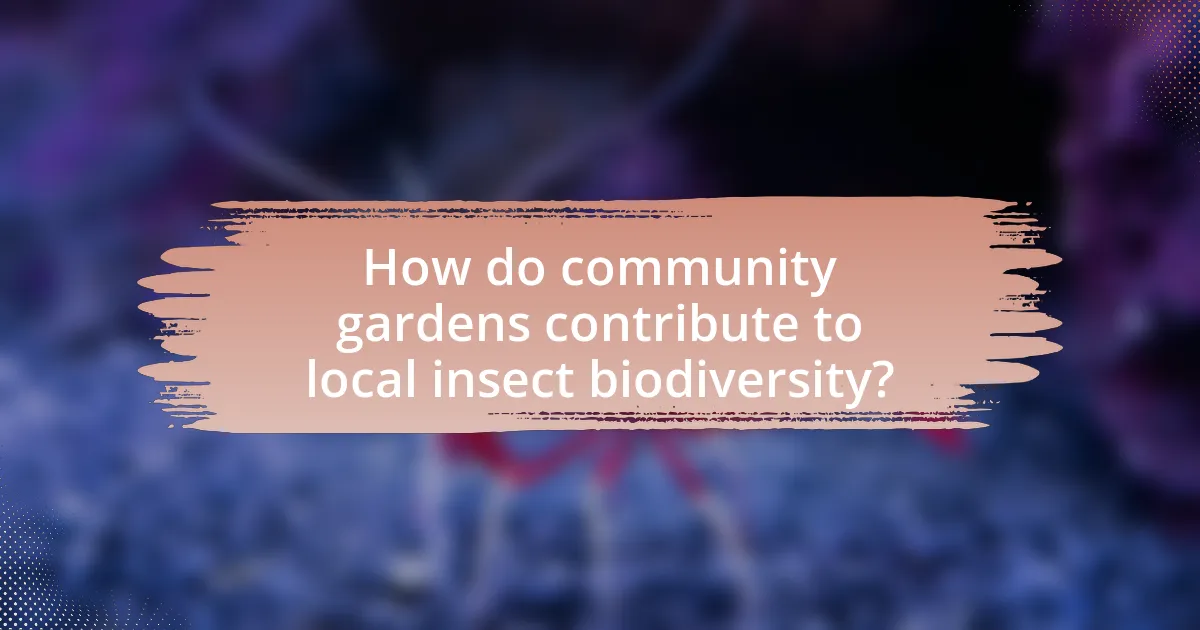
How do community gardens contribute to local insect biodiversity?
Community gardens contribute to local insect biodiversity by providing diverse habitats and food sources for various insect species. These gardens often feature a variety of plants, including native flowers, vegetables, and herbs, which attract pollinators such as bees and butterflies. Research indicates that gardens with higher plant diversity support a greater number of insect species, enhancing overall biodiversity. For example, a study published in the journal “Biodiversity and Conservation” found that urban gardens can significantly increase the abundance and diversity of pollinators compared to areas with less vegetation. Thus, community gardens play a crucial role in fostering insect biodiversity in urban environments.
What types of insects benefit from community gardens?
Community gardens benefit various types of insects, including pollinators like bees, butterflies, and hoverflies, as well as beneficial predatory insects such as ladybugs and lacewings. These insects thrive in community gardens due to the diverse plant species that provide food sources, habitat, and nesting sites. Research indicates that gardens with a variety of flowering plants attract a higher number of pollinators, enhancing local biodiversity and ecosystem health. For example, a study published in the journal “Ecological Applications” found that urban gardens significantly increase the abundance and diversity of pollinator species, demonstrating the positive impact of community gardens on insect populations.
How do pollinators thrive in community garden environments?
Pollinators thrive in community garden environments due to the diverse array of flowering plants that provide essential food resources. These gardens often feature a variety of native and non-native plants, which attract different species of pollinators, including bees, butterflies, and hummingbirds. Research indicates that gardens with a higher plant diversity can support a greater number of pollinator species, enhancing local biodiversity. Additionally, community gardens often incorporate practices such as organic gardening and reduced pesticide use, which create a safer habitat for pollinators. Studies have shown that these practices lead to increased pollinator populations and improved pollination services, benefiting both the gardens and the surrounding ecosystem.
What role do beneficial insects play in community gardens?
Beneficial insects play a crucial role in community gardens by enhancing pollination and controlling pest populations. These insects, such as bees, ladybugs, and lacewings, contribute to the reproductive success of flowering plants through pollination, which is essential for fruit and seed production. For instance, studies show that approximately 75% of the world’s flowering plants depend on animal pollinators, highlighting the importance of insects in maintaining plant diversity and productivity in community gardens. Additionally, beneficial insects like ladybugs and predatory wasps help manage harmful pest populations, reducing the need for chemical pesticides and promoting a healthier ecosystem. This natural pest control is vital for sustainable gardening practices, as it supports biodiversity and encourages a balanced environment.
Why are community gardens important for insect conservation?
Community gardens are important for insect conservation because they provide diverse habitats and food sources that support various insect species. These gardens often feature a wide range of plants, which attract pollinators like bees and butterflies, essential for maintaining healthy ecosystems. Research indicates that urban green spaces, including community gardens, can enhance local biodiversity by offering refuge and resources for insects that may be declining due to habitat loss in agricultural and urban areas. For instance, a study published in the journal “Biodiversity and Conservation” found that community gardens can significantly increase the abundance and diversity of pollinators compared to conventional landscapes.
How do community gardens provide habitats for various insect species?
Community gardens provide habitats for various insect species by offering diverse plant life, shelter, and food sources. The variety of flowering plants in these gardens attracts pollinators such as bees and butterflies, while the presence of native plants supports local insect populations. Additionally, the structural complexity of garden environments, including soil, mulch, and plant cover, creates microhabitats that protect insects from predators and harsh weather conditions. Research indicates that community gardens can enhance local biodiversity, with studies showing increased insect abundance and diversity in urban areas where such gardens are present.
What impact do community gardens have on local ecosystems?
Community gardens positively impact local ecosystems by enhancing biodiversity and providing habitats for various species. These gardens create green spaces that support pollinators, such as bees and butterflies, which are essential for plant reproduction. Research indicates that community gardens can increase the abundance and diversity of insects, contributing to healthier ecosystems. For instance, a study published in the journal “Urban Ecosystems” found that community gardens host a higher variety of insect species compared to conventional urban landscapes, demonstrating their role in promoting local biodiversity.

What practices in community gardening support insect biodiversity?
Practices in community gardening that support insect biodiversity include planting a diverse range of native plants, creating habitats such as insect hotels, and minimizing pesticide use. Diverse native plants provide essential food sources and habitats for various insect species, enhancing their populations. Insect hotels offer shelter for beneficial insects, promoting their presence in the garden. Additionally, reducing pesticide application protects non-target insect species, allowing for a more balanced ecosystem. Research indicates that gardens with higher plant diversity can support up to 50% more insect species compared to monoculture gardens, demonstrating the effectiveness of these practices in fostering insect biodiversity.
How can gardeners create insect-friendly environments?
Gardeners can create insect-friendly environments by incorporating native plants, which provide essential food and habitat for local insect species. Native plants are adapted to the local ecosystem and support a diverse range of insects, including pollinators like bees and butterflies. Research indicates that gardens with a higher diversity of native plants can support up to 50% more insect species compared to those with non-native plants. Additionally, minimizing pesticide use and implementing organic gardening practices further enhances the habitat quality for insects, promoting a balanced ecosystem.
What plants are best for attracting beneficial insects?
Plants that are best for attracting beneficial insects include marigolds, sunflowers, dill, fennel, and yarrow. These plants provide nectar and pollen, which are essential food sources for beneficial insects such as bees, ladybugs, and lacewings. Research indicates that diverse plantings in community gardens can significantly enhance insect biodiversity, as these plants create habitats that support various life stages of beneficial insects, promoting ecosystem health and pest control.
How does organic gardening promote insect health?
Organic gardening promotes insect health by creating a diverse and balanced ecosystem that supports beneficial insects. This approach avoids synthetic pesticides and fertilizers, which can harm insect populations, and instead utilizes natural methods such as companion planting and organic composting. Research indicates that organic gardens often have higher biodiversity, providing habitats and food sources for pollinators and other beneficial insects, which are crucial for ecosystem stability and agricultural productivity. For example, a study published in the journal “Agriculture, Ecosystems & Environment” found that organic farms had 50% more species of beneficial insects compared to conventional farms, demonstrating the positive impact of organic practices on insect health.
What community engagement strategies enhance insect biodiversity?
Community engagement strategies that enhance insect biodiversity include creating educational programs, promoting native plant gardening, and organizing citizen science initiatives. Educational programs raise awareness about the importance of insects and their roles in ecosystems, leading to increased community support for biodiversity efforts. Promoting native plant gardening provides essential habitats and food sources for local insect populations, as native plants are more beneficial than non-native species. Citizen science initiatives, such as monitoring insect populations or participating in biodiversity surveys, actively involve community members in conservation efforts, fostering a sense of stewardship and responsibility towards local ecosystems. These strategies collectively contribute to healthier insect populations and greater biodiversity in community gardens.
How can educational programs raise awareness about insects in gardens?
Educational programs can raise awareness about insects in gardens by providing hands-on learning experiences that highlight the ecological roles of these organisms. For instance, workshops can teach participants about beneficial insects, such as pollinators and pest controllers, emphasizing their importance in maintaining garden health. Research indicates that community engagement through educational initiatives increases knowledge retention; a study published in the Journal of Environmental Education found that interactive programs significantly enhance understanding of biodiversity. By incorporating activities like insect identification and habitat creation, educational programs can foster a deeper appreciation for the vital contributions of insects to garden ecosystems.
What role do local organizations play in supporting community gardens?
Local organizations play a crucial role in supporting community gardens by providing resources, funding, and expertise. These organizations often facilitate the establishment and maintenance of gardens through grants, educational workshops, and volunteer coordination, which enhances community engagement and sustainability. For instance, studies have shown that community gardens supported by local nonprofits can increase biodiversity, including local insect populations, by creating diverse habitats and food sources. This support not only fosters environmental benefits but also strengthens community ties and promotes local food systems.
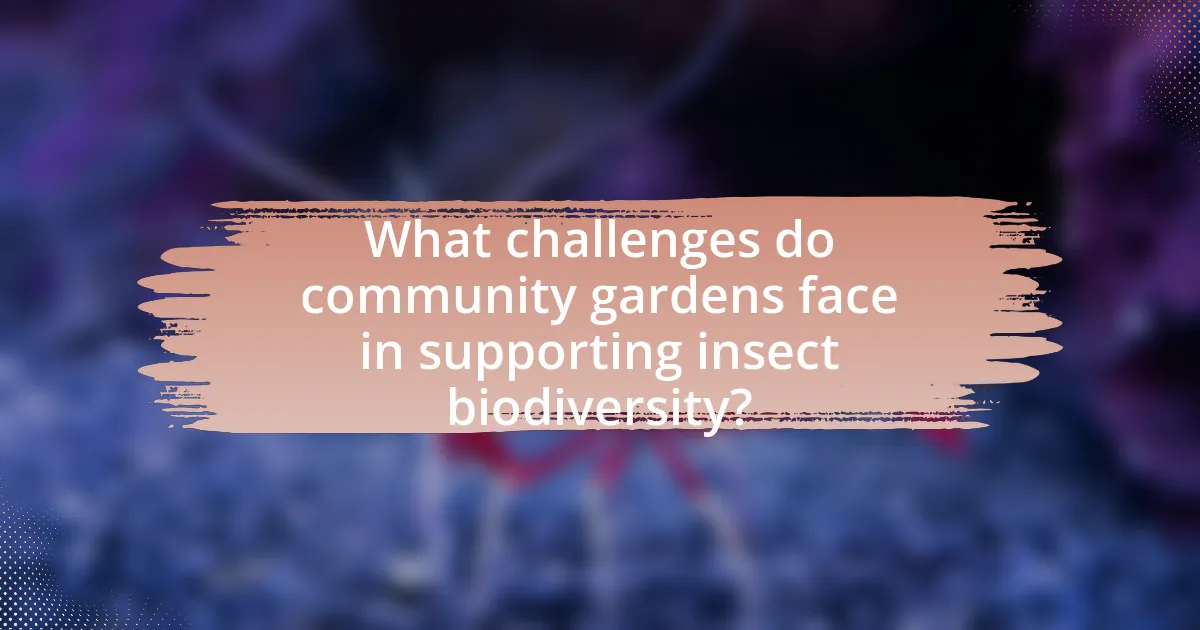
What challenges do community gardens face in supporting insect biodiversity?
Community gardens face several challenges in supporting insect biodiversity, primarily due to limited space, monoculture practices, and pesticide use. Limited space restricts the variety of plants that can be grown, which in turn reduces the diversity of habitats and food sources for insects. Monoculture practices, where a single crop is cultivated, further diminish biodiversity by providing fewer resources for various insect species. Additionally, the use of pesticides in community gardens can harm beneficial insects, disrupting the ecosystem balance necessary for supporting diverse insect populations. These factors collectively hinder the ability of community gardens to foster a rich insect biodiversity.
How do urbanization and land use affect community gardens?
Urbanization and land use significantly impact community gardens by influencing their availability, accessibility, and ecological function. As urban areas expand, green spaces often diminish, leading to a reduction in the number of community gardens. This loss of space can hinder local food production and decrease biodiversity, as gardens serve as vital habitats for various insect species. Research indicates that urban gardens can support up to 50% more insect species compared to surrounding urban landscapes, highlighting their role in promoting local biodiversity. Furthermore, land use policies that prioritize green spaces can enhance the sustainability and resilience of community gardens, thereby fostering a healthier urban ecosystem.
What are the threats posed by pesticides to insect populations?
Pesticides pose significant threats to insect populations by causing direct mortality, disrupting reproductive systems, and impairing immune responses. Studies indicate that neonicotinoids, a class of widely used pesticides, can lead to a decline in pollinator species, with research showing that exposure can reduce honeybee populations by up to 30%. Additionally, pesticides can alter the behavior of insects, making them more susceptible to predation and reducing their ability to forage effectively. The cumulative effects of these threats contribute to the overall decline in insect biodiversity, which is critical for ecosystem health and agricultural productivity.
How can community gardens mitigate the effects of climate change on insects?
Community gardens can mitigate the effects of climate change on insects by providing diverse habitats and food sources that support insect populations. These gardens create microclimates that can buffer temperature extremes and provide shelter from harsh weather conditions, which are increasingly prevalent due to climate change. Research indicates that increased plant diversity in community gardens enhances the resilience of insect communities, as diverse plant species attract a wider range of pollinators and beneficial insects. Additionally, community gardens often incorporate native plants, which are better adapted to local conditions and can thrive despite climate fluctuations, thereby sustaining local insect biodiversity.
What solutions can be implemented to overcome these challenges?
To overcome the challenges faced in supporting local insect biodiversity through community gardens, implementing diverse planting strategies is essential. Diverse plant species attract a wider range of insects, providing necessary habitats and food sources. Research indicates that gardens with a variety of native plants can increase insect diversity by up to 50%, as native species are more likely to support local pollinators and beneficial insects. Additionally, creating habitats such as insect hotels and leaving areas of the garden undisturbed can further enhance biodiversity. These solutions are supported by studies showing that structured habitats improve the survival rates of various insect species, thereby fostering a healthier ecosystem within community gardens.
How can community gardeners advocate for insect-friendly policies?
Community gardeners can advocate for insect-friendly policies by engaging with local government and community organizations to promote sustainable practices. They can organize workshops and informational sessions to educate the public about the importance of insect biodiversity, highlighting its role in pollination and ecosystem health. Additionally, community gardeners can collaborate with environmental groups to draft policy proposals that encourage the use of native plants and reduce pesticide use, which has been shown to harm beneficial insect populations. Research indicates that urban green spaces, including community gardens, can significantly enhance local biodiversity, making their advocacy efforts crucial for policy change.
What best practices can be adopted to enhance biodiversity in community gardens?
To enhance biodiversity in community gardens, practitioners should implement diverse planting strategies, such as incorporating native plants, which attract a variety of pollinators and beneficial insects. Research indicates that gardens with a higher diversity of plant species support more insect species, as native plants provide essential resources like nectar and pollen. Additionally, creating habitats such as insect hotels, brush piles, and water sources can further support local insect populations. Studies show that these practices not only increase insect diversity but also improve overall ecosystem health, making community gardens vital for local biodiversity.
What are practical tips for maximizing insect biodiversity in community gardens?
To maximize insect biodiversity in community gardens, implement diverse planting strategies that include native plants, flowering species, and a variety of plant heights. Diverse plantings attract a wider range of insects, including pollinators and beneficial predators. Research indicates that gardens with a mix of native flora can support up to 50% more insect species compared to monoculture gardens. Additionally, incorporating features such as water sources, shelter (like insect hotels), and minimizing pesticide use further enhances habitat suitability for insects. These practices collectively create a thriving ecosystem that supports local insect populations.
